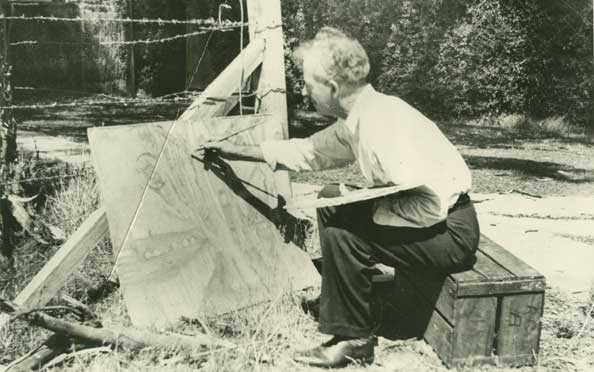
Photograph by Colin Ballantyne, Adelaide, 1940s
Though a number of works by Horace Trenerry shown here come from the Gallery’s Australian collection, the artist remains relatively unknown outside his home state of South Australia. Even there, such in the end was his sense of isolation, his name was not a household word like that of Hans Heysen, the iconic master of Hahndorf who the younger painter so admired in his formative years. Trenerry was born in 1899 in Adelaide, son of a butcher descended from Cornish immigrants who arrived in South Australia some time earlier in the nineteenth century. There he grew up and studied at various private art schools, and briefly the South Australian School of Arts and Crafts. His career began well in the early 1920s with regular exhibitions and sales, and in 1922-23 he made one of his rare excursions interstate, staying for 12-18 months in Sydney, where he studied at the Julian Ashton School and became friends with Elioth Gruner. However it was the influence of Heysen, in whose footsteps Trenerry followed with a painting expedition to the Flinders Ranges in 1930 out of which his unique vision evolved. Shortly after this trip he discovered the south coast region of Aldinga and Port Willunga, where during the 1930s his painterly language, allied with a gypsy-like existence amongst plains, hills, dilapidated farms and gently undulating dirt roads, began to blossom into a much bolder and poetic body of work. By the early 1940s he had become more impoverished financially, but with no falling away of a fierce dedication to painting, even if it meant occasional use of cheap materials such as powder pigments and, it was rumoured, plaster of Paris. Finally, the onset of Huntington’s Chorea, whose symptoms resembled extreme drunkenness, further added to his social alienation and neglect, and death in virtual anonymity at a home for incurables in 1958. This Focus Room exhibition focuses principally on Trenerry’s last fifteen years during which he painted more to please himself than for exhibitions, hence sales, which became progressively more sporadic. His paintings especially of the 1940s until his disease prevented him working by the end of the decade are daring and visionary. Blue outlines and heavy surfaces exude an emotionally obsessive alla prima involvement with the act of painting. With their dry, chalky surfaces and subtlety of light, they have often been compared to the work of van Gogh and Monet; although of course Trenerry never saw original examples of either. The enigmatic colourlessness of his late palette suggests he may have been familiar with the paintings of the British artist Gwen John, but in the end more directly relates to his own intensely felt sense of retreat and reverie within a privately apprehended world.
|